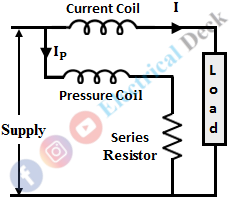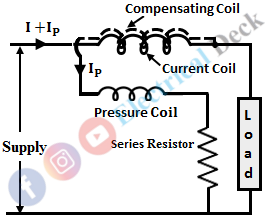A low power factor (LPF) wattmeter is an instrument used to measure power in low power factor circuits. This type of wattmeters is employed for power measurement in circuits whose power factor is less than 0.5.
Generally, wattmeters are used for measuring power in a circuit. But, the power measurement using normal electrodynamometer wattmeter in a circuit operating at low factors causes inaccurate in the readings due to the following reasons,- When the ordinary wattmeter is connected to a low power factor circuit. Even though at full excitation of current and voltage coil, the deflecting torque produced on the moving coil is very small.
- Wattmeter operating at low factors introduces large errors due to voltage coil inductance.
Hence, some additional features are incorporated into the ordinary electrodynamic wattmeter to overcome these difficulties. So that accurate readings can be obtained by the wattmeter when used in low power factor circuits.
Construction of Low Power Factor Wattmeter :
The construction of a low power factor (LPF) wattmeter is the same as that of an electrodynamometer type wattmeter with slight modifications for the compensation of errors.
Compensation of Error Due to Pressure or Voltage Coil Current :
When the pressure coil or voltage coil of the wattmeter is connected across the supply side as shown below. In low power factor circuits at low power, the current will be very high. Due to this, power loss in the current coil will be very high. Since the pressure coil is connected across the supply, the total power will be the sum of load power loss and power loss in the current coil. Thus large error will be introduced.
Suppose, if the pressure coil is connected at the load side as shown below. The total power measured will be not the power loss by the load. The wattmeter also reads the power consumed by the pressure coil which is considerable as compared with power to be measured which is small.
In order to nullify the errors due to pressure coil current, an additional winding known as compensating winding is used and is connected in series with the pressure coil as shown below. It is identical to the current coil and tightly wound with it to produce a field that acts in opposition to the field of the current coil due to load current.
The current in the current coil is the sum of load current I and the current through pressure coil, IP. The current coil produces a field proportional to (I + IP), whereas the pressure coil and compensating coil produce a field, proportional to IP.
Thus the field produced by the compensating coil neutralizes the field produced by the part of current i.e., IP, of the current coil. Hence, the effect of the pressure coil current is eliminated and the resultant field is due to current I only. Therefore, errors due to pressure coil current are nullified and compensated wattmeter shows no error.
In a low power factor wattmeter, the pressure coil area is increased so as to have a low value of resistance. Due to low resistance, a very high current flows through it producing a high value of operating torque.
Compensation of Error Due to Pressure or Voltage Coil Inductance :
We know that errors due to pressure coil inductance are proportional to sin Φ (where the magnitude of error is given by VI sin Φ tan Φ). The value of the power factor is low and hence the value of Φ is high hence sin Φ. In order to reduce this error, a capacitor is connected across the series resistor of the pressure coil circuit as shown below.
The presence of the capacitor will give a leading phase angle due to which the value of Φ, is small so the sin Φ is small. Hence reducing the error.
Therefore a modified electrodynamometer type wattmeter overcomes the difficulties at low power factors and obtains high accuracy, thus making it a Low Power Factor Wattmeter (LPFW).
Difference Between LPF and UPF Wattmeters :
| LPF Wattmeter | UPF Wattmeter |
|---|---|
| In the case of LPF wattmeter, the deflecting torque is small even when the current and pressure coils are fully energized (∵ Td ∝ cos Φ). | In the case of UPF wattmeters, deflecting torque is large. |
| The pressure coil current is very high. | The pressure coil current is small. |
| The error caused by pressure coil inductance is large. | The error caused by pressure coil inductance is zero. |
| The control torque is small. | The control torque is large. |
| The resistance of the pressure coil circuit is small. | The resistance of the pressure coil circuit is large. |
| In LPF wattmeters results are inaccurate. | In UPF wattmeters results are accurate. |




